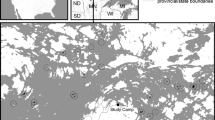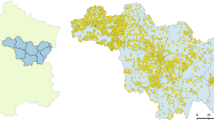Abstract
Over the past four decades, many researchers have applied the theory of island biogeography (IBT) to predict and understand species loss and distribution in fragmented landscapes. Recent studies found that specialist species were more affected by fragment size and isolation than generalists. However, the mechanisms underlying different effects of area and isolation among specialists and generalists are unknown. We tested the predictions of IBT on butterfly assemblages in Tokyo, Japan, and hypothesized that the effects of fragment size and isolation would be stronger for specialists than for generalists. We classified butterfly species into specialists and generalists for each of two dimensions (food range and voltinism) and according to tolerance to the matrix. We recorded 26 feeding specialists and 27 generalists, 24 seasonal specialists and 29 generalists, 32 low matrix-tolerant species and 21 high matrix-tolerant species in 20 forest fragments. We used generalized linear models to relate the number of species in a fragment to fragment size and isolation (distance to the mainland). The averaged models based on AICc showed that fragment size had positive and significant effects on both specialist and generalist and high matrix-tolerant butterfly species richness. However, the negative effects of isolation on species richness were only found in specialist and low matrix-tolerant species. Our results demonstrate that patch isolation only affects specialist species. This suggests that when applying IBT to terrestrial fragmented landscapes, researchers should be careful not to overlook patch area and isolation effects on specialists.


Similar content being viewed by others
References
Barton K (2009) MuMIn: multi-model inference (R package version 1.0.0). http://r-forge.r-project.org/projects/mumin/
Bastin L, Thomas CD (1999) The distribution of plant species in urban vegetation fragments. Landsc Ecol 14:493–507
Bellamy PE, Hinsley SA, Newton I (1996) Factors influencing bird species numbers in small woods in south-east England. J Appl Ecol 33:249–262
Bender DJ, Fahrig L (2005) Matrix structure obscures the relationship between interpatch movement and patch size and isolation. Ecology 86:1023–1033
Brose U (2003) Island biogeography of temporary wetland carabid beetle communities. J Biogeogr 30:879–888
Burnham KP, Anderson DR (2002) Model selection and inference: a practical information-theoretic approach. Springer, New York
Connor EF, McCoy ED (1979) The statistics and biology of the species–area relationship. Am Nat 113:791–833
Cook WM, Lane KT, Foster BL, Holt RD (2002) Island theory, matrix effects and species richness patterns in habitat fragments. Ecol Lett 5:619–623
Davies KF, Margules CR (1998) Effects of habitat fragmentation on carabid beetles: experimental evidence. J Anim Ecol 67:460–471
Dormann CF, Schweiger O, Augenstein I, Bailey D, Billeter R, de Blust G, DeFilippi R, Frenzel M, Hendrickx F, Herzog F, Klotz S, Liira J, Maelfait J, Schmidt T, Speelmans M, van Wingerden WKRE, Zobel M (2007) Effects of landscape structure and land-use intensity on similarity of plant and animal communities. Glob Ecol Biogeogr 16:774–787
Fahrig L (2003) Effects of habitat fragmentation on biodiversity. Annu Rev Ecol Evol Syst 34:487–515
Foley JA, DeFries R, Asner GP, Barford C, Bonan G, Carpenter SR, Chapin FS, Coe MT, Daily GC, Gibbs HK, Helkowski JH, Holloway T, Howard EA, Kucharik CJ, Monfreda C, Patz JA, Prentice IC, Ramankutty N, Snyder PK (2005) Global consequences of land use. Science 309:570–574
Forman RTT, Godron M (1986) Landscape ecology. Wiley, New York
Franklin JF (1993) Preserving biodiversity: species, ecosystems, or landscapes? Ecol Appl 3:202–205
Fukuda H, Hama E, Kuzuya T, Takahashi A, Tahakashi M, Tanaka B, Tanaka H, Wakabayashi M, Watanabe Y (1982) The life histories of butterflies in Japan, vol I. Hoikusha, Osaka (in Japanese)
Fukuda H, Hama E, Kuzuya T, Takahashi A, Tahakashi M, Tanaka B, Tanaka H, Wakabayashi M, Watanabe Y (1983) The life histories of butterflies in Japan, vol II. Hoikusha, Osaka (in Japanese)
Fukuda H, Hama E, Kuzuya T, Takahashi A, Tahakashi M, Tanaka B, Tanaka H, Wakabayashi M, Watanabe Y (1984a) The life histories of butterflies in Japan, vol III. Hoikusha, Osaka (in Japanese)
Fukuda H, Hama E, Kuzuya T, Takahashi A, Tahakashi M, Tanaka B, Tanaka H, Wakabayashi M, Watanabe Y (1984b) The life histories of butterflies in Japan, vol IV. Hoikusha, Osaka (in Japanese)
Gascon C, Lovejoy TE, Bierregaard RO Jr, Malcolm JR, Stouffer PC, Vasconcelos HL, Laurance WF, Zimmerman B, Tocher M, Borges S (1999) Matrix habitat and species richness in tropical forest remnants. Biol Conserv 91:223–229
Guldemond RAR, van Aarde RJ (2010) Forest patch size and isolation as drivers of bird species richness in Maputaland, Mozambique. J Biogeogr 37:1884–1893
Gustafson EJ, Gardner RH (1996) The effect of landscape heterogeneity on the probability of patch colonization. Ecology 77:94–107
Hanski I (1994) A practical model of metapopulation dynamics. J Anim Ecol 63:151–162
Hanski I, Gyllenberg M (1997) Uniting two general patterns in the distribution of species. Science 275:397–400
Jokimäki J, Huhta E (1996) Effects of landscape matrix and habitat structure on a bird community in northern Finland: a multi-scale approach. Ornis Fenn 73:97–113
Kataoka T, Tamura N (2005) Effects of habitat fragmentation on the presence of Japanese squirrels, Sciurus lis, in suburban forests. Mamm Stud 30:131–137
Kitahara M, Fujii K (1994) Biodiversity and community structure of temperate butterfly species within a gradient of human disturbance: an analysis based on the concept of generalist vs. specialist strategies. Popul Ecol 36:187–199
Koh LP, Sodhi NS, Brook BW (2004) Ecological correlates of extinction proneness in tropical butterflies. Conserv Biol 18:1571–1578
Kohn DD, Walsh DM (1994) Plant species richness—the effect of island size and habitat diversity. J Ecol 82:367–377
Kotze DJ, O’Hara RB (2003) Species decline—but why? Explanations of carabid beetle (Coleoptera, Carabidae) declines in Europe. Oecologia 135:138–148
Kupfer JA, Malanson GP, Franklin SB (2006) Not seeing the ocean for the islands: the mediating influence of matrix-based processes on the forest fragmentation effects. Glob Ecol Biogeogr 15:8–20
Kurosawa R, Askin RA (2003) Effects of habitat fragmentation on birds in deciduous forests in Japan. Conserv Biol 17:695–707
Laurance WF (1991) Edge effects in tropical forest fragments: application of a model for the design of nature reserves. Biol Conserv 57:205–219
Laurance WF, Yensen E (1991) Predicting the impacts of edge effects in fragmented habitats. Biol Conserv 55:77–92
Lomolino MV, Brown JH, Davis R (1989) Island biogeography of montane forest mammals in the American southwest. Ecology 70:180–194
MacArthur RH, Wilson EO (1967) The theory of island biogeography. Princeton University Press, Princeton
Magura T, Ködövöcz V, Tóthmérész B (2001) Effects of habitat fragmentation on carabids in forest patches. J Biogeogr 28:129–138
McKinney ML (2002) Urbanization, biodiversity, and conservation. Bioscience 52:883–890
Ministry of Agriculture, Forestry and Fisheries (2010) Homepage. http://www.maff.go.jp/j/tokei/index.html
Nagase T (2004) Takao, Jinbasan no tyou. Keyaki, Tokyo (in Japanese)
Norton MR, Hannon SJ, Schmiegelow FKA (2000) Fragments are not islands: patch vs landscape perspectives on songbird presence and abundance in a harvested boreal forest. Ecography 23:209–223
Öckinger E, Smith HG (2006) Landscape composition and habitat area affects butterfly species richness in semi-natural grasslands. Oecologia 149:526–534
Pianka ER (1978) Evolutionary ecology. Harper and Row, New York
Pollard E (1977) A method for assessing changes in the abundance of butterflies. Biol Conserv 12:116–134
Prugh LR, Hodges KE, Sinclair ARE, Brashares JS (2008) Effect of habitat area and isolation on fragmented animal populations. Proc Nat Acad Sci USA 105:20770–20775
R Development Core Team (2010) R: a language and environment for statistical computing. R Foundation for Statistical Computing, Vienna
Ricketts TH (2001) The matrix matters: effective isolation in fragmented landscapes. Am Nat 158:87–99
Ries L, Debinski DM (2001) Butterfly responses to habitat edges in the highly fragmented prairies of Central Iowa. J Anim Ecol 70:840–852
Shapiro AM (1975) The temporal component of butterfly species diversity. In: Cody ML, Diamond JM (eds) Ecology and evolution of communities. Belknap, Harvard University, Cambridge, pp 181–195
Sisk TD, Haddad NM, Ehrlich PR (1997) Bird assemblages in patchy woodlands: modeling the effects of edge and matrix habitats. Ecol Appl 7:1170–1180
Soga M, Koike S (2012) Life-history traits affect vulnerability of butterflies to habitat fragmentation in urban remnant forests. Ecoscience 19(1). doi:10.2980/19-1-3455
Tischendorf L, Bender DJ, Fahrig L (2003) Evaluation of patch isolation metrics in mosaic landscapes for specialist vs. generalist dispersers. Landsc Ecol 18:41–50
Tokyo Metropolitan Government (2000) Tokyo road side tree map. Tokyo Metropolitan Government, Tokyo (in Japanese)
Umetsu F, Metzger JP, Pardini R (2008) Importance of estimating matrix quality for modeling species distribution in complex tropical landscapes: a test with Atlantic Forest small mammals. Ecography 31:359–370
Vos CC, Stumpel HP (1995) Comparison of habitat isolation parameters in relation to fragmented distribution patterns in the tree frog (Hylea arborea). Landsc Ecol 11:203–214
Watling JI, Nowakowski AJ, Donnelly MA, Orrock JL (2011) Meta-analysis reveals the importance of matrix composition for animals in fragmented habitat. Grob Ecol Biogeogr 20:209–217
Zimmerman K, Fric Z, Filipová L, Konvička M (2005) Adult demography, dispersal and behaviour of Brenthis ino (Lepidoptera: Nymphalidae): how to be a successful wetland butterfly. Eur J Entomol 102:699–706
Zschokke S, Dolt C, Rusterholz HP, Oggier P, Braschler B, Thommen GH, Ludin E, Erhardt A, Baur B (2000) Short-term responses of plants and invertebrates to experimental small-scale grassland fragmentation. Oecologia 124:559–572
Acknowledgments
We thank Y. Yamaura and two anonymous referees for fruitful suggestions. This study was funded by the Urban Green Tech Japan, and Fuji Film Green Foundation.
Author information
Authors and Affiliations
Corresponding author
About this article
Cite this article
Soga, M., Koike, S. Patch isolation only matters for specialist butterflies but patch area affects both specialist and generalist species. J For Res 18, 270–278 (2013). https://doi.org/10.1007/s10310-012-0349-y
Received:
Accepted:
Published:
Issue Date:
DOI: https://doi.org/10.1007/s10310-012-0349-y




